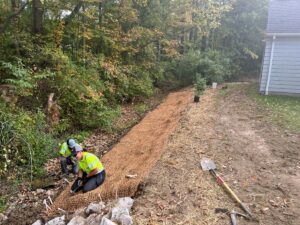Cost-Share Assistance for Streambank Stabilization
Chagrin River Watershed Partners completed a program which provided cost-share assistance to landowners wishing to stabilize eroding streambanks on their properties. The Chagrin River Watershed Landowner Cost-Share Streambank Stabilization Program was supported through a $194,278.00 Great Lakes Sediment and Nutrient Reduction Program grant which paid for 50% of the construction costs, 100% of design and engineering costs, and technical assistance for the streambank stabilization work. The grant was awarded by the Great Lakes Commission and in cooperation with the U.S. Department of Agriculture’s Natural Resource Conservation Service and the U.S. Environmental Protection Agency.
CRWP advertised the opportunity for cost-share assistance to interested landowners in the Chagrin River Watershed through a public meeting, direct mailings, and media outreach. Sites were selected based on factors such as erosion severity, potential pollutant reductions, and construction access considerations. Landowners at selected sites contributed a total of $100,000 in cost-share funds. In 2022, CRWP conducted a competitive process to select an experienced design-build streambank stabilization contractor to complete the design, engineering, permitting, construction, and vegetative plantings at each site. Davey Resource Group and their construction partner Marks Construction were chosen as the design-build team for the program. The team has experience with many successful ecological restoration projects in Northeast Ohio.
The Chagrin River Watershed Landowner Cost-Share Streambank Stabilization Program stabilized a total of 2,000 linear feet of eroding streambanks. This work will reduce 2,880 tons of sediment and 2,880 pounds of phosphorus, a form of nutrient pollution, to the Chagrin River and ultimately to Lake Erie. In October, CRWP had the opportunity to highlight the Program at the Healing Our Watershed Great Lakes Coalition Conference. The 2023 Conference, held in Cleveland, hosted hundreds of environmental and conservation professionals from around the Great Lakes region.
The Great Lakes Commission was created by the eight Great Lakes states in 1955, recognizing the Great Lakes as environmental and economic assets to the United States and Canada and a need to protect these assets. The Great Lakes Commission recommends policies and practices to balance the use, development, and conservation of the water resources of the Great Lakes and brings the region together to work on issues that no single community, state, province, or nation can tackle alone. The Great Lakes Sediment and Nutrient Reduction Program is a state and federal partnership managed by the Great Lakes Commission in cooperation with the U.S. Department of Agriculture’s Natural Resource Conservation Service, the U.S. Environmental Protection Agency, and the eight Great Lakes states. The Great Lakes Sediment and Nutrient Reduction Program provides grants to local and state units of government and nonprofit organizations to install erosion and sediment control practices in the Great Lakes basin.
This material is based upon work supported by the Natural Resources Conservation Service, U.S. Department of Agriculture, under number NR193A750022C001. Any opinions, findings, conclusions, or recommendations expressed in this publication are those of the author(s) and do not necessarily reflect the views of the U.S. Department of Agriculture. USDA is an equal opportunity provider and employer. See https://www.usda.gov/non-discrimination-statement for more information.
- Continue to project story map







